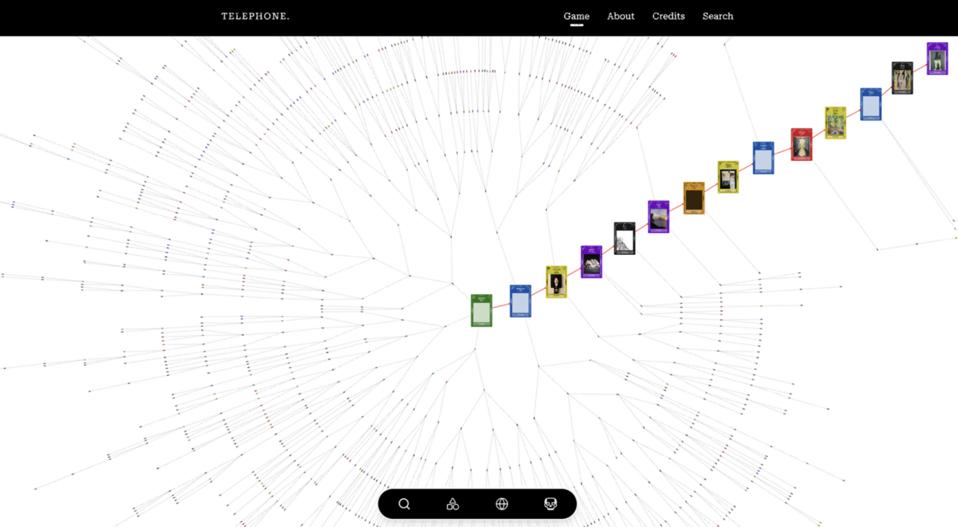On May 24, I received my assignment email:
“It’s time. To see the work that has been assigned to you to translate, please click the following link. You are allotted 14 days to finish your work and upload it.”
A few weeks earlier, I had signed up to participate in Telephone — a global art project where artists translate another person’s work into their own, and then pass their creation along for more artists to interpret.
The email continued:
“The artwork you have been assigned contains and transmits a very specific message. The artworks that came before did the same. Interpret the message you receive and pass it along faithfully with your own art. Trust that if you invest yourself in the process of translation, no matter how abstract your form of art, the message will come through.”
I spent hours contemplating the piece I was sent—a dark, beautiful painting that looked to me like a mummy rising from tree roots, flowers spilling from its mouth, a pumpkin cradled in its arms, and a rainbow-like aura radiating around it. The words that eventually whispered to me: “it’s never too late.”
I translated that message quite literally, using a mix of mediums. I cut and engraved plywood into the shape of a coffin, embroidered an old upholstery sample with flowers and those same words, and glued it all together. The result was a ten-inch-tall 3D wall hanging with an optimistically morbid message of hope.
At the time of this writing, I don’t know the identity of the artist that I took my inspiration from, nor the artists or artworks that were born from mine. But this Friday, I will find out.
Telephone, described as “a game of art whispered around the world,” launches on October 10, 2025, featuring 1,395 works by artists in 930 cities across 65 countries. The launch will include an interactive digital experience connecting every artwork and artist profile, along with in-person events in many participating cities.
Nathan Langston, the project’s director, has described Telephone as an antidote to loneliness. “Making any art is a wildly ambitious act of hope, a message in a bottle cast into the vast emptiness of the ocean,” he wrote in an email to artists. “Almost every work of art ever created could be aptly titled Please Understand Me.”
That message is relevant far beyond the art world — especially in how we work today.
In an age where loneliness has been declared an epidemic affecting half of U.S. adults, and where our creative networks are often limited by geography, culture, or class, Telephone offers a lesson that leaders can learn from.
Even as technology makes it easier than ever to connect across continents, people feel increasingly isolated. The same paradox defines modern work: we’ve never been more digitally connected, yet emotionally distant.
According to 2025 Gallup research, among U.S. employees whose jobs can be done remotely, 28% now work fully remote, 51% are hybrid, and just 21% are fully on-site. Most people prefer this flexibility—a 2025 FlexJobs survey found that 58% of workers want to be fully remote and 40% prefer hybrid schedules. But while remote work has enabled companies to hire across geographies and tap into broader diversity of talent, it’s also changed how—and how deeply—we connect.
Research from Nectar revealed that 70% of employees would be happier and more committed to their work if they had deeper connections with their colleagues. This makes sense, as belonging has been shown to drive engagement, retention, and innovation. Yet the mechanisms that once nurtured belonging—office rituals, casual hallway conversations, shared experiences—are often not available.
Telephone shows another way: connection through creation. None of the 1,395 participating artists met in person to collaborate. Yet together, we created a single, global artwork. Each person contributed their voice to something larger—not because of proximity, but because of a shared purpose and a longing for artistic connection.
The same can be true for distributed teams. When leaders design systems where ideas can flow, creativity can compound, and people feel seen and valued, remote collaboration becomes more human.
Remote work is not the absence of culture—it’s the test of it. It challenges leaders to replace physical proximity with purpose, and casual encounters with conscious design. The best teams build rituals that carry meaning across distance: shared creative practices, open communication channels, and moments of genuine connection.
As Langston put it, “Everything is connected and everything influences everything else. It’s within this vast web of causality that we find our own perfectly unique and non-replicable voices.”
Those unique voices are what fuel innovation and creativity in the workplace. When there are pathways for people to pass along their ideas, and a shared purpose that everyone is working towards, incredible results can emerge.

